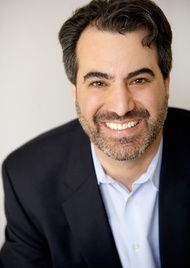By: Ron Pernick

Let me get this out right up front: I’m not a fan of Donald Trump and I won’t be voting for him. Over the past year, I’ve been both captivated and repulsed by the Republican presidential candidate’s bullying tactics, outlandish lies, and seeming joy in stirring up deep-seated hatred and fear. And when it comes to my area of professional expertise, clean tech, I’ve been equally frustrated and confounded. As a firm believer in the need to apply advanced technologies and smart policies in the battle against human-caused pollution and climate change, I am dismayed (though not surprised) that Trump, and the Republican Party’s national platform, would take such an oppositional stance toward clean-energy solutions.
In an atmosphere of record-setting global temperatures, uncontrollable flooding and fires, and a growing chorus of business, religious, policymaker, and public support for a clean-energy transition, it makes the Republicans (at the presidential and national level at least) look antiquated and deeply out of touch.
Here are some highlights of the two major party candidates and their respective platforms on clean energy and climate change.
Hillary Clinton | Donald Trump |
Like the vast majority of scientists, believes that climate change is real and that humans are having an impact on the global climate | Doesn’t believe in climate change, has called it a hoax
|
Supports the Environmental Protection Agency’s Clean Power Plan to reduce greenhouse gases | Plans to rescind many of Obama’s executive actions including the Climate Action Plan
|
Embraces solar and wind energy and wants to turn the U.S. into a “renewable energy superpower” | Claims he will save the coal industry if he’s president
|
Proposes the expansion of solar power by 700% by the end of her first term
| Has attacked the wind industry for bird deaths, without acknowledging that buildings (like the ones with his name on them) are responsible for far more bird deaths than the wind industry |
Calls on the U.S. to generate enough electricity from renewable sources to power every American home within ten years of taking office | Promises to ask TransCanada to renew its permit application for the Keystone pipeline
|
Has suggested the creation of a $60 billion competitive grant program to incentivize states, cities and rural communities to become clean-energy leaders | Says he will cancel the Paris Climate Agreement and stop all payments of U.S. tax dollars to U.N. programs addressing global warming
|
Calls for the elimination of billions of dollars in tax subsidies to oil and gas companies and to instead invest in clean energy | Repeatedly talks about how “expensive” solar and wind power are, seemingly unaware of the fact that these technologies have reached cost parity across diverse geographies |
Talk about an ideological chasm.
Back in 2012, Clint Wilder and I published our second book, Clean Tech Nation, which focused on how the U.S. could remain competitive in the global race toward a clean-tech future, and in which we outlined a Seven-Point Action Plan for the country. At the time, we reached out to a diverse group of politicians, businesspeople, investors, and others to provide early reviews, including those on the left, right, and in between. We were thrilled when former President Bill Clinton offered up the following assessment: “Clean Tech Nation dares to imagine a country in which bipartisanship reigns, green energy is our nation’s greatest national resource, and our competitive edge in the global economy is restored.”
Clinton’s quote perfectly reflected some of the key themes and aspirations in our book:
Bipartisanship:
Clean energy should be treated not as a partisan divide, but as the unifying force that it is. In my June column, I highlighted the fact that red and blue states equally comprised the Top 10 states for solar and wind deployment in 2015. In polling, Americans of all political stripes and affiliations overwhelmingly support renewables. It’s time that our political parties caught up with the rest of the nation.
National Resource:
The U.S. possesses a rich and diverse clean-energy resource base, spanning solar, wind, hydro, geothermal, biomass, and more. Last year, for example, solar and wind represented more than 60% of new electricity capacity additions. And for 2016, the EIA projects that utility-scale solar (not including distributed on-site solar generation) will outpace both natural gas and wind power in terms of total capacity additions, with a projected 9 GW installed. Talk about a national resource!
Economic Competitiveness:
At Clean Edge, we firmly believe that the U.S. economy remains intricately linked to breakthroughs and deployment in green buildings, renewable energy, energy storage, advanced agriculture, electrified transportation, and other emerging clean-tech sectors. China, Germany, Japan, and other nations are aggressively pursuing these industries as well, and we ignore these opportunities, from an economic perspective, at our peril.
Below is a slightly updated Seven-Point Action Plan from our 2012 book. I believe this plan still offers a strong blueprint (and insights) for a potential national clean-energy strategy.
- Enact a National Renewable Electricity Standard of 50% by 2040
- Create and Fund a National Smart Infrastructure Bank
- Leverage Proven Investment Tools from Oil, Gas, and Real Estate Sectors (such as MLPs, REITs, etc.)
- Phase out all Energy Subsidies within 10 Years (to Level the Playing Field)
- Foster Open-Source Collaboration to Set Clean-Tech Standards
- Fund Military Initiatives on Energy and Water Security
- Launch Federally Backed Prizes for Clean-Tech and Climate Innovation
Based on their statements and positions, it’s obvious which of the current major party candidates will support the clean-energy aspirations of the majority of Americans – Democratic, Republican, Independent, Libertarian, Green, or other. My advice: if you want to ensure that renewables continue to trump fossil fuels, vote for Hillary Clinton.
______________________________________________________
Ron Pernick is founder and managing director of research and advisory firm Clean Edge and the coauthor of two books on clean-tech business trends and innovation, Clean Tech Nation (HarperCollins, 2012) and The Clean Tech Revolution (HarperCollins, 2007).

